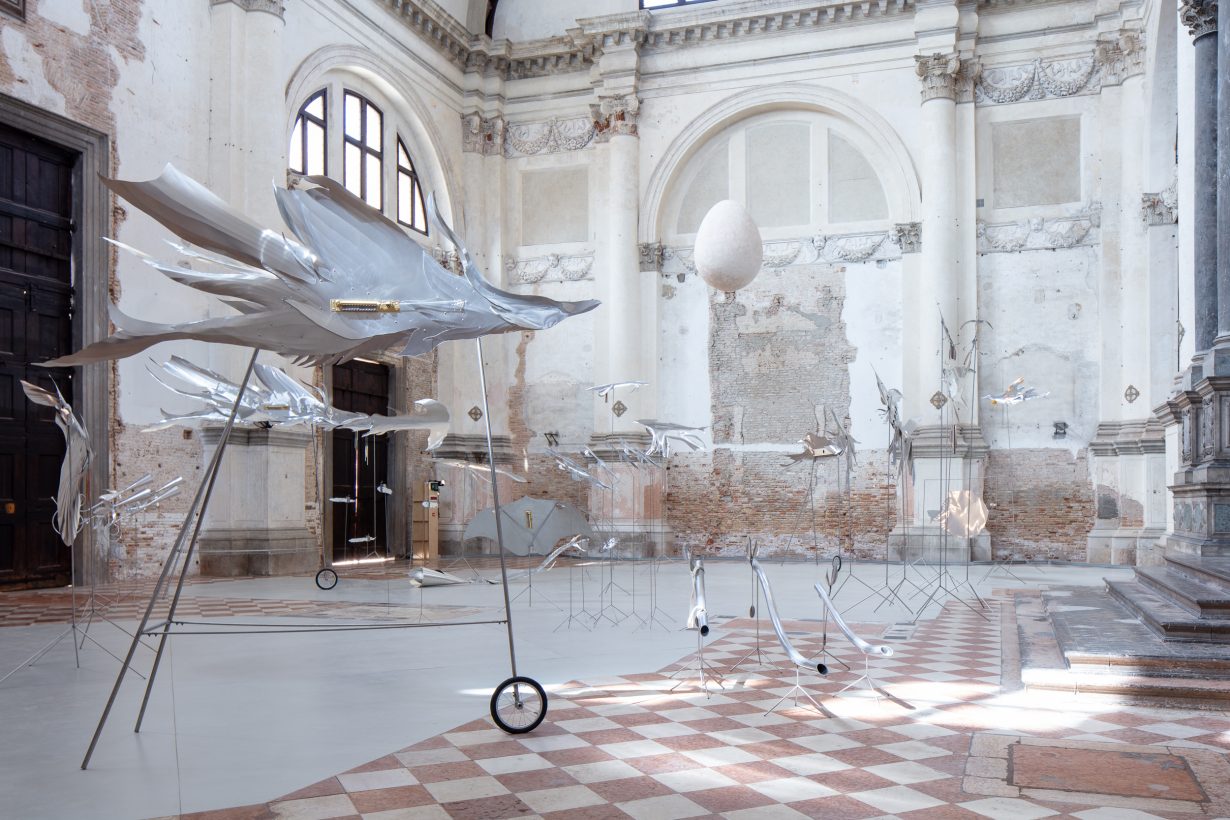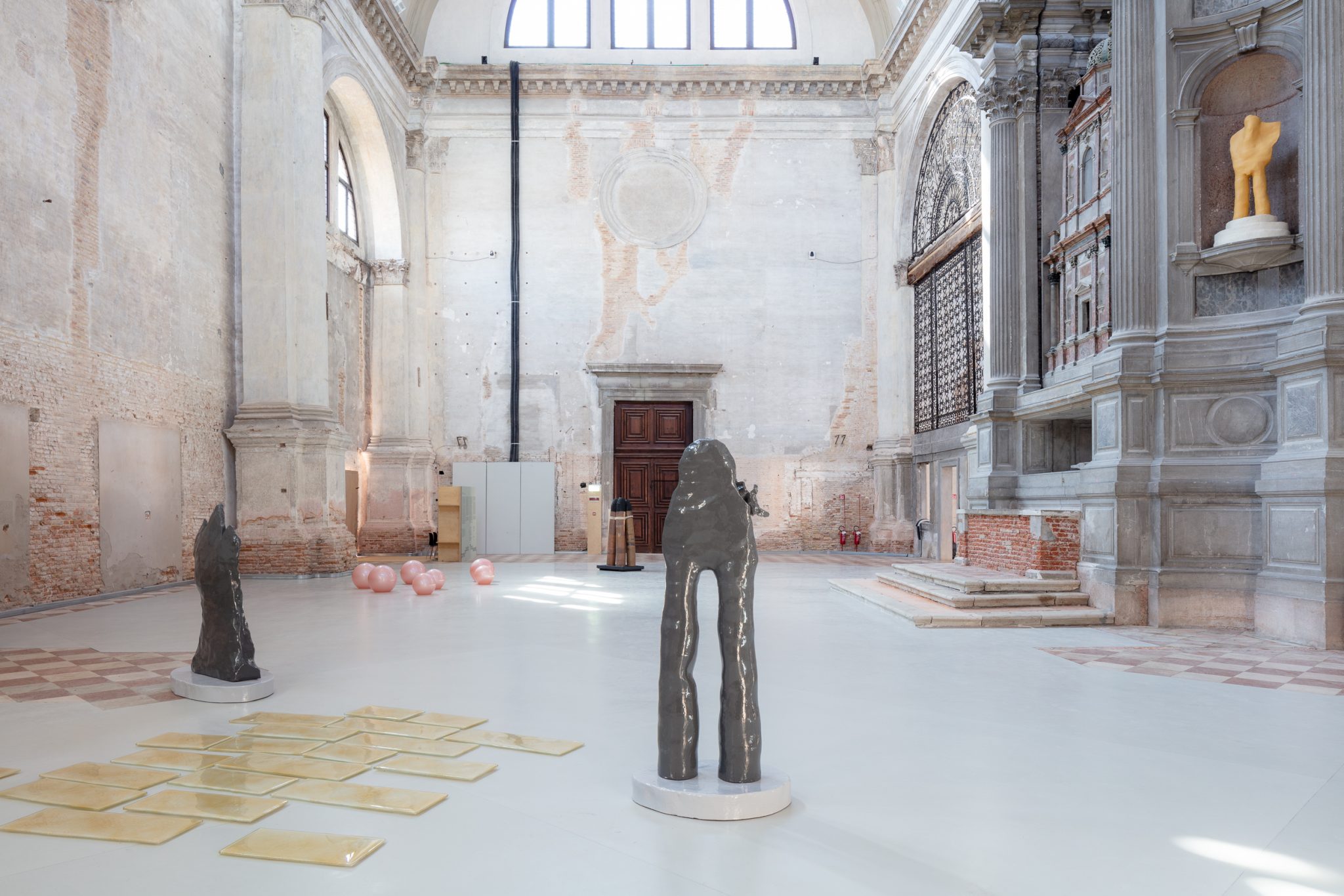Simone Fattal, Petrit Halilaj and Álvaro Urbano come together to compose a musical ode to the ocean that goes beyond technical jargon and dire predictions
Catch the ebb and flow of acqua alta, the seasonal high tide in the Venetian lagoon, and you’ll be acutely aware of how fast both Venice is sinking and the sea rising. Water laps at the threshold of San Lorenzo, a deconsecrated church that in 2019 became home to Ocean Space, where TBA21 – Academy convenes artists and scientists to consider the effect of climate change on marine ecosystems and that is currently hosting a two-part exhibition comprising a collaborative installation by Petrit Halilaj and Álvaro Urbano, and new sculptures by Simone Fattal. The exhibition, curated by Barbara Casavecchia, is the culmination of three years of walks, talks and research conducted by the artists; yet Thus waves come in pairs is refreshingly free of the technical jargon or dire predictions that often characterise shows about climate change, instead immersing itself in the poetics of art.
The exhibition takes its title from ‘Sea and Fog’, a 2012 poem by Fattal’s late partner, the artist and writer Etel Adnan, who died in 2021 and whose spirit hovers over the works on view. A pair of gentle, Gumby-like ceramic figures at near-human scale represent Máyya and Ghaylán, mythic lovers from classical Arabic poetry who captained rival fleets of pearling vessels in the Persian Gulf. According to legend, Máyya commands the faster ships until a dragonfly alights on Ghaylán’s shoulder, inspiring him to invent the sail. Fattal has sculpted the form of the insect’s carapace atop Ghaylán’s broad, headless torso. Another male figure, glazed pale yellow, has been placed in the high, empty niche of the church’s baroque altar; like its counterparts, it seems to predate the church, and even the city, around it. Fattal’s archaic visions nod to the Muslim world with which the city-state of Venice was often at war, aptly sited here atop what was the final burial place of that most famous Venetian seafarer, Marco Polo.

Visitors to Fattal’s presentation first pass through Lunar Ensemble for Uprising Seas (all works 2023), a luminous installation by Petrit Halilaj and Álvaro Urbano, co-commissioned by Audemars Piguet Contemporary. Forty-two fish-shaped instruments, fashioned from aluminium, will be played by an ensemble of two dozen musicians throughout the run of the show. When I previewed the work, I pulled paper strips cut in the shape of minnows through two small music boxes, making them play; another music box has been embedded in the metallic body of a stingray, whose fins can be flapped, amplifying its sound. A school of silvery trumpet-fish curl into horns, while a large flat creature resembling a halibut holds a hurdy-gurdy in its belly. A pair of fish on high wheeled- poles play, when pushed, the opposing notes of Ay mi pescadito deja de llorar (Ye-ho little fish, don’t cry), a lullaby Urbano told me his grandmother sang to him as a child. Originally performed in English by Spencer Tracy in Captains Courageous, a 1937 coming-of-age film about a Portuguese fishing vessel in the North Atlantic, it became a popular song of Republican liberation during the Spanish Civil War (1936–39): ‘You go to fish school and can learn from a book / How not to get caught on the fisherman’s hook. / Watch out, little fish, we’re out after you, / But you can escape away deep in the blue’. It’s nearly impossible to play both fish in perfect synchrony, a playful way to allude, perhaps, to the anthropogenic fact that the world’s ecosystems are now in a constant state of disequilibrium. Nonetheless, the slim chance that the song might eventually ring through this former Benedictine monastery, once famous for its liturgical music, points to the promise of an ‘uprising’ – against climate change or other manmade atrocities – indicated by the work’s title.
At various times of day, light filters through the clerestory windows of San Lorenzo and strikes the aluminium fish, which glitter like the canal water just outside the door – an effect as strikingly evanescent as the music they produce. In this sense, Halilaj and Urbano’s sculptures aim, sometimes successfully, to appear as alive as the creatures they imitate. The artists, partners in work and life, are the second queer couple whose creativity is celebrated by this show, provocatively situated in a former Catholic sanctuary. There may be little hope for the oceans’ full renewal, but if they are to survive, their future will be different – even queer. We’ll need art and poetry as much as science to imagine what that will look like.
Thus waves come in pairs at Ocean Space, Venice, through 5 November
